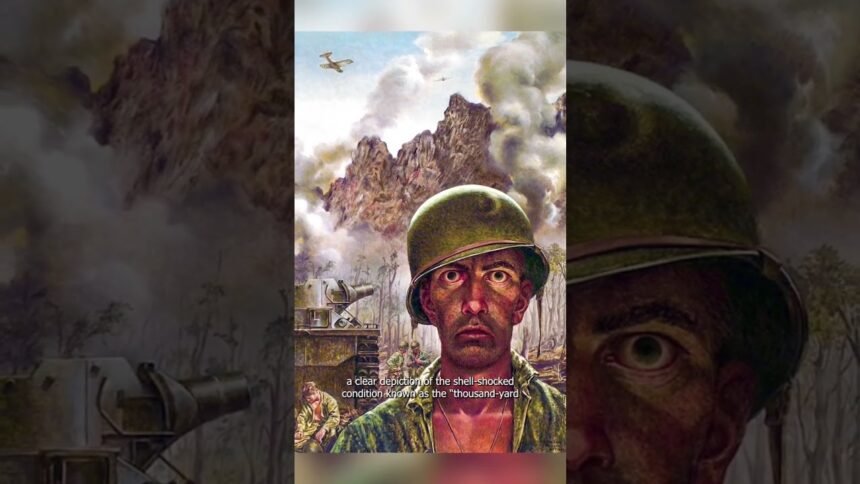The phrase “2000 yard stare” has long been synonymous with the blank, haunted expression of soldiers who have been exposed to the overwhelming horrors of war. Increasingly than just a vacant look, it embodies a state of mind shaped by the lattermost trauma, emotional detachment, and psychological suffering. First coined during World War II, the 2000 yard stare has since wilt a powerful symbol of the effects of prolonged combat, seeming in literature, art, and media as a visual representation of the toll that war takes on the human spirit.
In this article, we’ll swoop deep into the origin, significance, and ongoing relevance of the 2000 yard stare, exploring how it reflects the mental and emotional impact of mismatch on soldiers both past and present.
The Origin of the 2000 Yard Stare
The term “2000 yard stare” is believed to have originated during World War II, specifically about a painting by U.S. Marine Corps gainsay versifier Tom Lea. His 1944 portrait of a battle-hardened Marine, titled “The 2000 Yard Stare,” captured a soldier with a hollow, unfocused expression—a man who had seen too much death, destruction, and suffering to fully engage with the present.
This squint was not uncommon among soldiers in the thick of combat. It reflected a state of psychological dissociation, a coping mechanism to mentally uncouple from the traumatic and violent experiences surrounding them. The phrase soon became part of the military lexicon, describing soldiers who seemed emotionally numbed, as if they were physically present but mentally distant.
Though the term has roots in World War II, it represents a universal wits shared by soldiers throughout history. The 2000 yard stare is not unseated to any single conflict; rather, it speaks to the mental and emotional toll of war that transcends generations and geographical boundaries.
The Psychological Impact of War: What Lies Behind the Stare
At its core, the 2000 yard stare is a manifestation of what psychologists would now recognize as gainsay stress, or in increasingly severe cases, post-traumatic stress disorder (PTSD). For soldiers, the wits of war often involve witnessing and participating in violent, life-threatening situations that can leave lasting emotional scars.
Psychologically, the smart-ass reacts to these intense stressors by inward survival mode. In the midst of combat, soldiers might wits hypervigilance, emotional numbing, or dissociation, all as ways of coping with the overwhelming fear, anxiety, and shock of battle. This dissociation, in particular, is closely linked to the 2000 yard stare, where soldiers wilt uninfluenced from their surroundings as a form of self-preservation.
After the intensity of gainsay subsides, many soldiers protract to wits these symptoms, often leading to long-term psychological issues like PTSD. The blank, afar squint associated with the 2000 yard stare can persist, for plane long without a soldier has returned home. In these cases, the stare is not just an outward expression of fatigue or shock but moreover an indication of unresolved trauma.
The 2000 Yard Stare in Art and Popular Culture
The 2000 yard stare has transcended its military origins and made its way into broader popular culture, often serving as a poignant symbol of the human forfeit of war. Beyond Tom Lea’s iconic painting, the stare has been depicted in myriad photographs, films, and books, each portraying the emotional toll of mismatch on the individual.
In literature, the concept of the 2000 yard stare can be found in works ranging from archetype war novels to modern-day finance of conflict. Authors often use it as a literary device to illustrate the mental disorientation and psychological fragmentation that soldiers wits without prolonged exposure to combat.
In the film, the stare has wilted a visual shorthand for the psychological wounds of war. Characters who walk out the 2000 yard stare in movies often do so without witnessing the lattermost violence or without surviving a traumatic event, highlighting their internal struggle to process their experiences. In films like Full Metal Jacket or Saving Private Ryan, scenes that depict soldiers with vacant stares serve as powerful reminders of the lasting impact of war on the mind.
In photography, images of soldiers—past and present—captured with a 2000 yard stare protract to evoke strong emotional responses. These haunting images often convey a sense of loss, both personal and collective, as they depict the human squatter of war’s inhumanity.
Modern-Day Relevance of the 2000 Yard Stare
While the phrase “2000 yard stare” has its roots in the 20th century, its relevance extends to the modern-day experiences of soldiers and veterans. Today, military conflicts, whether in Afghanistan, Iraq, or other war zones, protract to expose soldiers to the same intense stressors and traumas that produced the 2000 yard stare during World War II.
Mental health sensations and treatment for PTSD have certainly improved since the early days of gainsay stress recognition, but many veterans still struggle with the long-term psychological effects of war. The 2000 yard stare remains a potent visual and cultural symbol, highlighting the fact that, despite advances in medical and psychological care, the psychological impact of war remains profound.
Beyond the battlefield, the concept of the 2000 yard stare has found resonance in civil life as well. Individuals who have experienced the lattermost trauma—whether through natural disasters, violent crime, or other life-threatening situations—can walk out similar dissociative symptoms. The stare, in this broader sense, has come to represent the human topics for emotional detachment in the squatter of overwhelming stress.
The Connection Between the 2000 Yard Stare and PTSD
It’s important to note the connection between the 2000 yard stare and post-traumatic stress disorder (PTSD), a mental health condition that affects a significant percentage of veterans. PTSD can develop without someone having been exposed to traumatic events, such as combat, and its symptoms include flashbacks, nightmares, emotional numbness, and hyperarousal.
The 2000 yard stare often serves as an early warning sign of PTSD, as it reflects the dissociation and emotional withdrawal that are hallmarks of the disorder. While the stare itself is not a diagnosis, it is commonly accompanied by other symptoms of gainsay stress, making it an important indicator of the mental health struggles many soldiers squatter without returning from war.
Effective treatment for PTSD includes therapy, medications, and support systems that help veterans process their trauma and regain the tenancy of their lives. In recent years, there has been growing recognition of the need to provide comprehensive mental health superintendency to soldiers, ensuring that those who suffer from PTSD receive the help they need to heal.
Conclusion: A Lasting Symbol of War’s Toll
The 2000 yard stare remains one of the most haunting and suggestive symbols of the psychological forfeiture inflicted by war. It is a stark reminder of the emotional forfeit that soldiers pay, often long without the fighting has ended. Whether it’s captured in a painting, a photograph, or a film, the stare speaks to the inner turmoil experienced by those who have witnessed the unimaginable.
As we protract to grapple with the realities of modern warfare and the mental health challenges faced by veterans, the 2000 yard stare serves as a reminder of the need for compassion, understanding, and comprehensive support for those who withstand the scars of combat. Whether on the battleground or when home, the impact of war is far-reaching, and the 2000 yard stare is a powerful testament to the rememberable consequences of human conflict.







